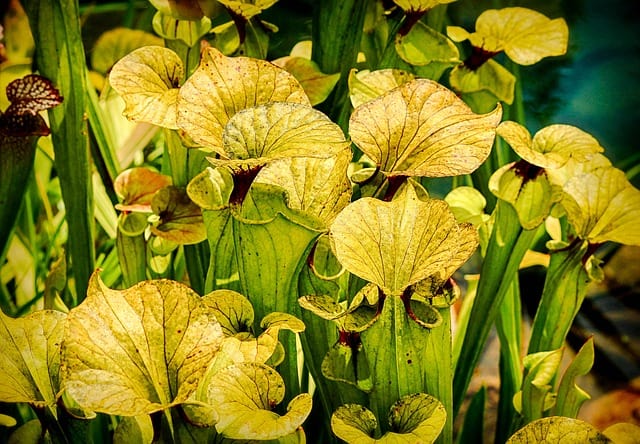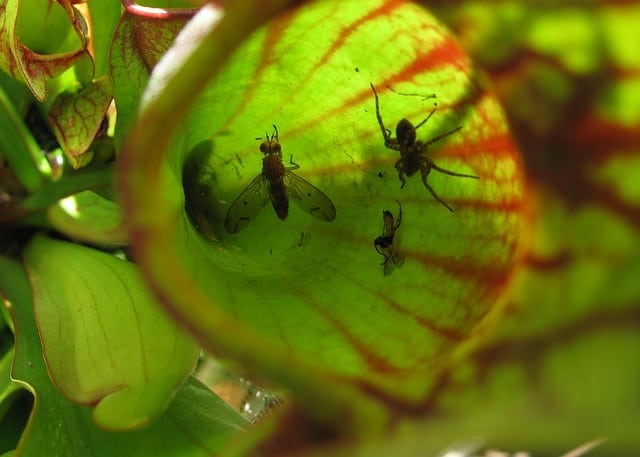Pitcher plants are carnivorous plants that depend on insects for their nutrition. They have leaf modifications that look like pitchers, which they use to trap insects.
These plants attract the insects with nectar and then drown them in the digestive liquid present in the pitcher sac.
These plants are climbers and they try to attain optimal heights so as to be available to the gullible insects. These plants can be grown indoors and they actually look great.
They can be grown in a window sill or terrarium. If proper care is taken, they will thrive indoors and add elegance to your beautiful home.
People write to me that their Pitcher plant is turning yellow, it may happen for many reasons.
Why is my pitcher plant turning yellow?
Older leaves die naturally and they become yellow before dying. This is a completely natural process and the older pitchers would get replaced by new pitchers in weeks.
If the entire plant is becoming yellow, there must be something wrong. Here are the possible reasons.
Watering
Overwatering and Underwatering have always caused problems for plants. Just give your pitcher plants adequate water and they’ll grow just fine.
Sunlight
Pitcher plants’ leaves turn yellow when scorched under direct sunlight. That doesn’t mean they don’t like sunlight. They do. They embrace indirect sunlight.
Nitrogen deficiency
Every plant needs nitrogen from the time they sprout. Pitcher plants need nitrogen too.
Pitcher plants, unlike other plants, meet most of their nitrogen requirements through organic break-down of insects.
Indoor Pitchers mostly suffer from nitrogen deficiency due to a lack of insects.
Trace element deficiency
If your Pitcher plant is yellow even after feeding it bugs at the right time, something else is wrong. Your Pitcher plant might be lacking some essential elements.
How do you revive a dying pitcher plant?
Your Pitcher plant may be suffering from one of the above issues. If you don’t act quickly, you may further deteriorate the plant’s health.
Let’s see how you can turn your yellow plant green.
Water them just enough
This is a biggie! I’ve seen many people who overwater their pitcher plants. Pitcher plants love damp to wet soil. Water the plants from below, rather than showering the leaves.
Keep the soil around the pitcher plant moist, not soggy. Only use distilled or rainwater. Using salt water may damage the pitchers.
Having a good drainage system in place in your terrarium helps a lot.
Should I fill my pitcher plant with water?
Pitchers of these plants have bacteria that help them digest insects. These bacteria thrive only in moist pitchers, so make sure the pitchers have adequate water in them.
How often should I water my Nepenthes?
Check the dampness of the soil with your fingers, if it feels dry only then water the soil.
Additional tips
- You may want to use a tray below the pitcher plant’s pot and add surplus water to the tray. The plant will absorb adequate water itself. If you do this, you can avoid overwatering and root rotting of your beautiful Pitcher plants. Fill the tray to 1/4th the height of the nepenthes pot and refill it if the level falls below 1/4th of an inch.
- Use RO water or rainwater, this is ideal for the Pitcher plants as they grow in soils with negligible minerals.
- Water from the Condensation line of an Air Conditioner or Heat pump works great.
Adequate Sunlight
If you keep them in a terrarium, make sure they get bright light for at least 8 hours in the summer and 14 hours in other seasons.
Do pitcher plants like full sun?
Keep them near a window sill, away from direct sunlight. A day of indirect sunlight is sufficient for pitcher plants.
Tip: The color of the pitchers depends a lot on the amount of light it gets, make sure it gets adequate light.
Feed them well!
Make sure they get sufficient insects to munch on as it’s the way they choose to obtain nitrogen. Among all the carnivorous plants, Pitcher plants are probably the easiest to feed.
Fortnightly feeding
They need a lot of nutrients during their growing season. So, be sure to supply them with bugs every 2 to 3 weeks.
If the pitchers are dry they can’t absorb the organic material of the bugs, so add some drops of water using an eyedropper.
Wingless and flightless fruitflies are popular feed for Nepenthes. Bean beetles are another good source of nitrogen for them.
They don’t need to be fed at all during the dormant phase.
Don’t use chemical fertilizers
If you are just getting to know Pitcher plants, I advise you not to use any chemical fertilizer at all. There’s a very good chance of you over-fertilizing and burning your Pitcher plants.
Be careful while feeding your pitcher plants, gently place them inside the pitcher and allow the lid to close on its own.
I’ve seen some people feeding animal meat to their pitcher plants, do not do this. This can damage the pitcher.
Tip: The insects you feed the Pitcher plant should be 1/3rd the size of the pitcher you’re feeding.
Give ’em Trace Elements
Plants need micro/trace elements like Copper, Manganese, Boron, etc. to thrive. If you feed your plants on time and sufficiently but the leaves still turn yellow, a deficiency of microelements is possible.
If you sorted out all the above factors well, you may need to give your Nepenthes some microelements. Dilute down an orchid fertilizer and spray some on your Pitcher plants.
Wrappin’ it up
Pitcher plants can be grown indoors if you are diligent. As you probably understood by now, watering and sunlight are the two major factors that affect Pitcher plants’ growth.
Pitcher plants usually come in pots with no drainage holes. So, you may need to carefully repot the plant into a pot with a good drainage facility. Trust me, this can make a lot of difference.
Supply water and light adequately and you’ll see your window sills decorated by colorful pitchers in no time!


